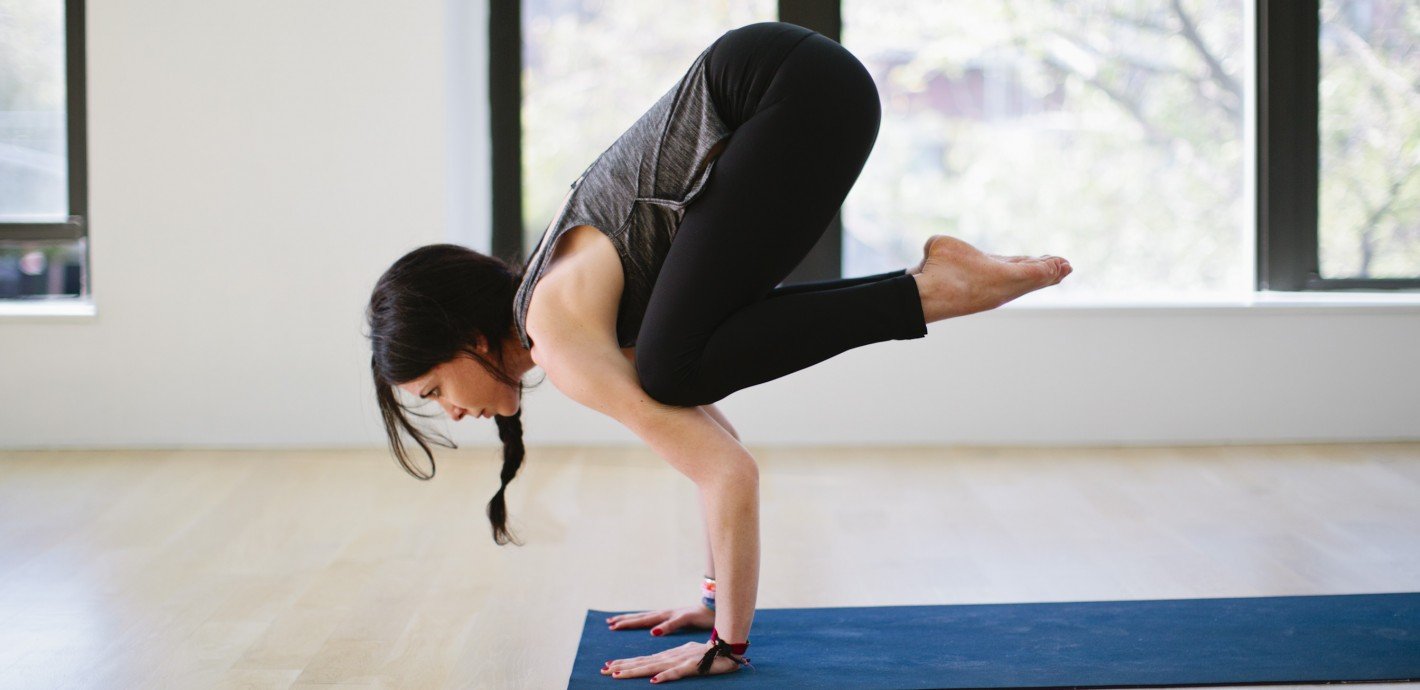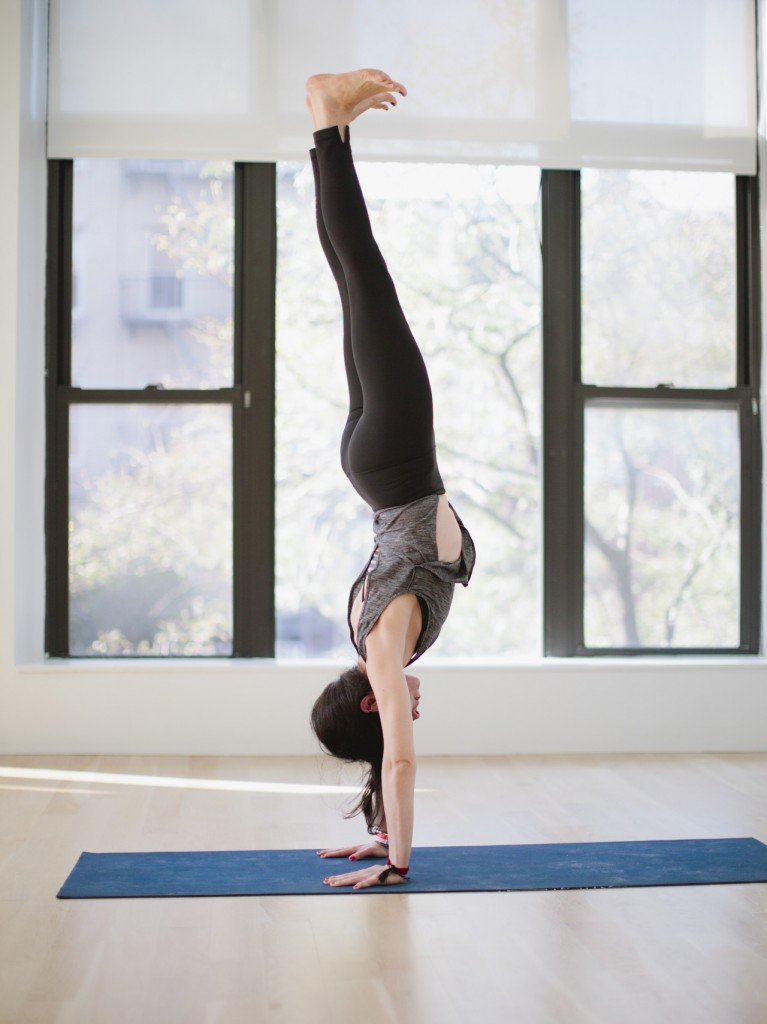As humans, we all have a tendency to try to control what cannot be controlled. For some, this leads to a perpetual practice of non-confrontation, moderation, and “playing it safe.” For others, fear of stillness upends fear of movement, and constant change becomes the safety net.
The desire for comfort is natural, for safety is the basis of a healthy life. Without a safe root we have no foundation to build upon. If one is too stuck in her ways, however, eventually habit and routine can create rigidity and blind us from acknowledging the number of possibilities in life. But if we find ourselves in a habit of addictive risk taking, whereby the risks take us further and further away from the now, we risk the ability to see our truth and to ground down into our roots. In yoga, we confront these concepts most viscerally in inversions.
Inversions, such as headstand and handstand, energize and realign us both mentally and physically. When we are upside down there is very little space to think, to ponder, to question. We achieve balance when our effort finds its softness, and we are nowhere else in our thoughts or in our body except in the inversion itself; we’re in the moment. Joints and organs realign in inversions, such that our entire body is stacked into perfect balance. With lungs and heart above the head, the nervous system slows down, and—though counterintuitive at first glance—the body finds a sense of ease, as does the mind.
In Sanskrit, handstand is Urdvhavrksasana, or upside down tree. Just as trees extend their roots down into the earth, we do the same. Roots anchor strong trunks, which unfold and grow into branches, leaves, flowers, and fruits. The deep roots of a tree are directly correlated to its capability for expansion, growth, and life.
In yogic thought, there are two opposing energies—prana and apana—which are constantly working together to keep us balanced. The bones in our body have an apanic, or downward moving energy, while our breath has pranic or upward moving energy. When we are flipped upside down, our hands, forearms, and head press downward for strength, but our breath and our energy move upward for balance and intention. Everything in the body—the bones, the breath, the muscles, the joints, and the intention—must align in order for us to find balance upside down. Though our gaze is often down, our internal gaze is always inward and upward, signifying the posture’s yearning for ascension into the infinite energy above.
This practice takes work; each muscle must be awakened, just as each thought must be directed in order to hold inverted balance for more than a few breaths. It is nearly impossible to dissociate the physical growth of finding the shape to the psychological growth in attaining it, both of which are deeply tied to overcoming the fear of falling.
For many, falling is associated with failing. It is natural, therefore, that it’s scary to flip our world upside down. It would mean losing all sense of control. Control is very much based on the things we know. With knowledge comes fear of experiencing something that we perceive as painful. When we were younger we cartwheeled and tumbled about without a care in the world. We had fewer experiences, less knowledge, and less fear about confronting our true selves. In opening ourselves up to the inversion practice, we must cultivate a childlike sense of freedom and fearlessness. And if it is true that inversions flip our world upside down and shift our perspective, then the very practice of inversions helps shift our negative predisposition toward falling.
But falling isn’t always joyous. Sometimes it hurts. Sometimes it’s ungraceful. Sometimes we knock other practitioners off balance in our quest to find it. But this is all part of the practice, for it is only through pain, sorrow, and the release of the ego that we can deeply grow our compassion and wisdom. Indeed “falling in love”, which is perhaps the deepest and most fundamental human emotion, is about releasing oneself to the power of falling, of letting go and allowing oneself to be led by the heart. So how can we figure out how to embrace falling? Courage, support, and patience.
Patience in building the foundation of the shape, in toning and attuning each muscle required for inverting, is reflective of our ability to build patience in everyday life. The focus created while upside down parallels our quest to find focus in strange and difficult life situations. Handstands are dependent on consistent personal practice—one must work toward handstands every day with courage and love. What’s more, one must not become too attached to the attainment of the posture itself. Yoga teaches us that handstands, like all else, are fleeting; we must not take their presence or their absence for granted. If we are aligned with our intention, the physicality will come.
Lastly and most importantly, in learning to invert, we will inevitably fall at some point, and most likely more than once! We’ll fall, and we’ll learn how to fall softly and gently, just as we will fall in life. And then we’ll get back up, with new learning and less fear.
So how do we do it? How do we build the strength to do a handstand? In order to flip our perspective, both physically and mentally, we need to develop strength and control throughout the body, from the legs through the core and into the upper body. We need our roots to grow branches. Keeping all these aspects in mind, and inviting a childlike playfulness into the practice, click on the photo below for a nice sequence that helps to find the strength and the sensations of handstand:
Remember, you can’t just expect things to happen on your first attempt. Try to show up for these shapes every day and notice the changes in your body, breath, and attitude. Victor Frankl wrote, “When we can no longer change a situation we are challenged to change ourselves.” When we accept change into our personal practice, we realize that all things are constantly changing. We become more willing to accept and challenge change as it comes. So as you make the leap towards physical and spiritual flight, stay open to the possibility that at any moment, your truth could be turned upside down, that you might fall, that you might laugh, and that always you will get back up.
Photos by Hailey Wist










Comments (0)